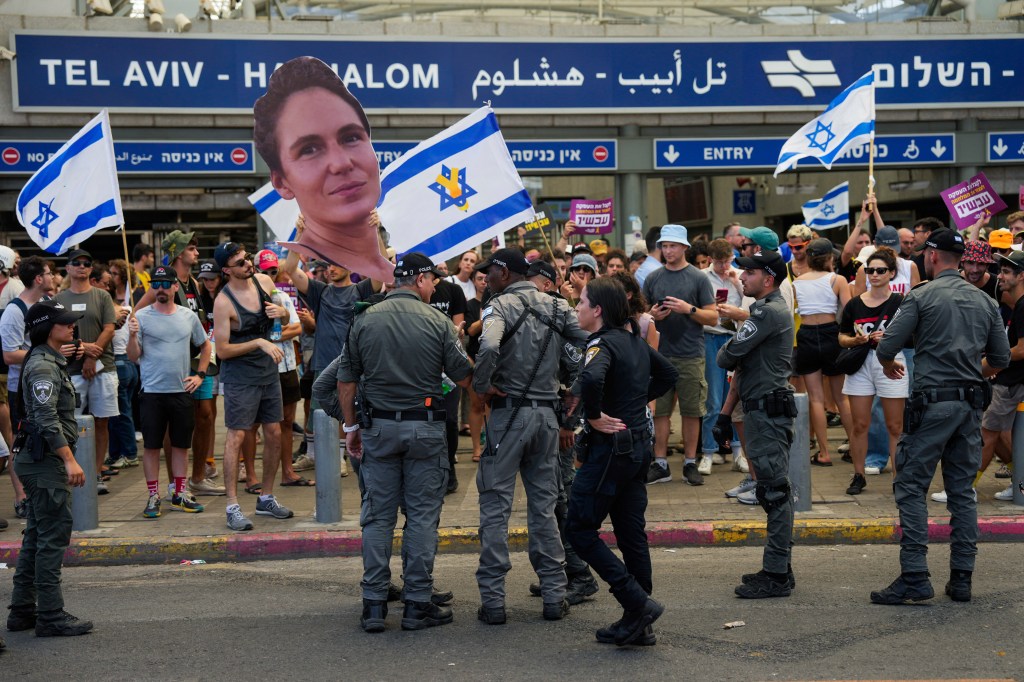TEL AVIV, Israel — A rare call for a general strike in Israel to protest the failure to return hostages held in Gaza led to closures and other disruptions around the country on Monday, including at its main international airport. But it was ignored in some areas, reflecting deep political divisions.
Hundreds of thousands of Israelis poured into the streets late Sunday in grief and anger after six hostages were found dead in Gaza. The families and much of the public blamed Prime Minister Benjamin Netanyahu, saying they could have been returned alive in a deal with Hamas to end the nearly 11-month-old war.
But others support Netanyahu’s strategy of maintaining military pressure on Hamas, whose Oct. 7 attack into Israel triggered the war. They say it will force the militants to give in to Israeli demands, potentially facilitate rescue operations and ultimately annihilate the group.
A labor court ruled that the strike must end by 2:30 p.m. local time, accepting a petition from the government saying it was politically motivated.
The head of Israel’s largest trade union, the Histadrut, said it would abide by the court decision and instructed members to return to work. Arnon Bar-David had called for the general strike, the first since the start of the war. It aimed to shut down or disrupt major sectors of the economy, including banking and health care.
Airlines at Israel’s main international airport, Ben-Gurion, halted outgoing flights between 8 a.m. and 10 a.m. Those flights either departed early or were slightly delayed. Arriving flights continued as usual, according to the Israel Airports Authority.
“There’s no need to punish the whole state of Israel because of what is happening, overall, it is a victory for Hamas,” said one passenger, Amrani Yigal.
But in Jerusalem, resident Avi Lavi said that “I think this is fair, the time has come to stand and to wake up, to do everything for the hostages to come back alive.”
The Histadrut said banks, some large malls and government offices had joined the strike, as well as some public transit services, although there did not appear to be major disruptions.
Municipalities in Israel’s populated central area, including Tel Aviv, participated, leading to shortened school hours. Other municipalities, including Jerusalem, did not participate.
The demonstrations on Sunday appeared to be the largest since the start of the war, with organizers estimating that up to 500,000 people joined nationwide events and the main rally in Tel Aviv. Israeli media estimated that 200,000 to 400,000 took part.
They are demanding that Netanyahu reach a deal to return the remaining roughly 100 hostages held in Gaza, a third of whom are believed to be dead, even if it means leaving a battered Hamas intact and withdrawing from the territory. Many Israelis support this position, but others prioritize the destruction of the militant group over freedom for the hostages.
Netanyahu has pledged “total victory” over Hamas and blames it for the failure of the negotiations, which have dragged on for much of this year.
Israel said the six hostages found dead in Gaza were killed by Hamas shortly before Israeli forces arrived in the tunnel where they were held. Three were reportedly scheduled to be released in the first phase of a cease-fire proposal discussed in July. The Israeli Health Ministry said autopsies had determined the hostages were shot at close range and died on Thursday or Friday.
Netanyahu blamed Hamas, saying “whoever murders hostages doesn’t want a deal.”
Hamas blamed their deaths on Israel and the United States, accusing them of dragging out the talks by issuing new demands, including for lasting Israeli control over two strategic corridors in Gaza. Hamas has offered to release the hostages in return for an end to the war, the complete withdrawal of Israeli forces and the release of a large number of Palestinian prisoners, including high-profile militants.
One of the six hostages was Israeli-American Hersh Goldberg-Polin, 23, a native of Berkeley, California, who lost part of his left arm to a grenade in the Oct. 7 attack. In April, Hamas issued a video that showed him alive, sparking protests in Israel.
He was one of the best-known hostages, and his parents had led a high-profile campaign for the captives’ release, meeting with President Joe Biden, Pope Francis, and addressing the Democratic National Convention last month.
Around 400 mourners gathered ahead of Goldberg-Polin’s funeral outside the family residence, still draped with posters reading “Bring Hersh Home.” Waving Israeli flags, they marched toward the cemetery.
“It feels like he could have been my son,” said Irit Dolev, whose two sons went to school with him.
“I’ve buried so many friends this year, but this is the hardest one, because he was alive,” said Amit Levy, who was among hundreds of others at the cemetery.
Some 250 hostages were taken on Oct. 7. More than 100 were freed during a cease-fire in November in exchange for the release of Palestinians imprisoned by Israel. Eight have been rescued by Israeli forces. Israeli troops mistakenly killed three Israelis who escaped captivity in December.
Hamas-led militants killed some 1,200 people, mostly civilians, when they stormed into southern Israel on Oct. 7. Israel’s retaliatory offensive in Gaza has killed over 40,000 Palestinians, according to local health officials, who do not say how many were militants.
The war has displaced the vast majority of Gaza’s 2.3 million people, often multiple times, and plunged the besieged territory into a humanitarian catastrophe, including new fears of a polio outbreak.
Associated Press writers Julia Frankel and Melanie Lidman in Jerusalem contributed.


